#Emporion
Explore tagged Tumblr posts
Text
Bastidor de hierro de un scorpio (catapulta romana) hallado en Empúries y del s.I a.C o s.I

Puede visitarse en la exposición Imperium del Museu arqueològic de Barcelona.
#arqueologia#historia#culture#history#archaeology#antiguaroma#restosromanos#roma#museuarqueologicbarcelona#museo archeologico#barcelonaromana#empuries#emporion
2 notes
·
View notes
Text
Colonización griega: Emporion

View On WordPress
0 notes
Text

Corinthian Whipped Bronze Helmet, 560 BC.
It was discovered in 1930 in the Ria de Huelva, (Spain).
According to the analyses carried out by Dr. Gomez Torga, director of the laboratory of the Mines de la Reunion, in Rio Tinto, it is pure copper, without any kind of alloy.
In any case, this unique piece is one of the most important Greek finds of the Iberian Peninsula. By its location, it must be related to the emporion or commercial factory of Huelva, where numerous remains have appeared that evidenced trade between the Greeks and the Tartesians, which boomed in the middle of the sixth century BC. C, coincides with the date of this helmet, to which elites it would be intended as a weapon of prestige acquired to highlight to society the aristocratic status of its owner.
It was acquired by purchase, by the engineer José Albelda, who later donated it in 1932, to the Royal Academy of History.
Height: 26.6 cm, Width: 33.6 cm
Thickness: between 0.1 cm and 0.4 cm, but reaches 1.3 cm in the nasal defense.
Weight: 1370.5 g.
Indeed, the place of the finding is not too far from where it was recovered, also in a dredging of the River, a famous set of weapons of the Final Bronze, which makes it assumed that all these objects were deposited as exvotes or offerings to the divinity of those waters.
Water represented the passage point of Mas Allá in the Indo-European world, so this kind of offerings could be related to rites of arrival or passage, as can be interpreted another Greek helmet, something earlier, found in the waters of the Guadalete river, on its way through Arcos of the Frontier, which is preserved in the Museum of Jerez.
Source: Royal Academy of History. Text from the Catalogue of the exhibition Treasures of the Royal Academy of History. 2001. Sign written by Martín Almagro Gorbea.
#art#history#design#style#archeology#antiquity#sculpture#spain#greece#helmet#ex voto#ria del huelva#copper
259 notes
·
View notes
Text

Pottery recipient in the shape of the river god Achelous. Found in the Ancient Greek colony of Emporion, modern-day Empúries (Comarques Gironines, Catalonia).
Museu d'Arqueologia de Catalunya - Girona.
#arqueologia#història#empúries#catalunya#arts#ancient greek#ancient greece#archeology#archaeology#catalonia#pottery#ceramics#arts and crafts#tagamemnon#classics#museum#europe#southern europe
24 notes
·
View notes
Photo

Empuries
Empuries (also Emporiae or Emporion) was a Greek and then Roman colony on the northeastern coast of Spain. Thriving as a local and Mediterranean trading centre, it prospered from the 6th century BCE to the 2nd century CE. Several times the Romans used the port as a landing place for armies to invade and plunder Iberia and they established a military camp at the site which evolved into a small town embellished with the usual collection of Roman architectural features. The site today offers the visitor extensive ruins, notably a large portion of the city walls, a crytpoportico, forum space, and large private houses.
Historical Overview
Empuries was established by settlers from Massalia (Marseilles) in the 6th century BCE who founded the port of Palaeopolis on an island at the mouth of the Fluvia River. The settlers prospered through trade and then spread to the Greek town known as Neapolis near the coast which covers about 4 hectares. The two areas were called Emporion, indicative of their dependence on trade, where wine, pottery, and olive oil, along with goods from Massalia and those of Etruscan origin, were exchanged for metals and foodstuffs from the local tribes reached via the River Fluvia and the nearby River Ter.
The Romans used the port during the Second Punic War against Carthage, with Scipio Africanus landing expeditions there in 218 and 211 BCE, and again in 195 BCE when Marcus Porcius Cato led a force to quash the Iberian revolt which sprang up in reaction to Rome's demands for tribute. From 100 BCE, in order to create a more permanent base from which to exploit Iberia and protect the trade route from Italy, they built a Roman town from the original army camp. Located on the coast opposite from the Greek town, which had by then covered all of the island, the Roman town was laid out in right-angled blocks and eventually spread to cover some 22.5 hectares. The town received another boost when Julius Caesar settled veterans from his legions there in 45 BCE.
In the reign of Augustus (27 BCE – 14 CE) the two still separate towns and a nearby indigenous Iberian settlement (Indika) were combined and awarded the status of municipium, which was given the collective name Emporiae. The town had its own forum, agora, small amphitheatre, gymnasium, and walls, and continued to mint its own coinage (which began in the 5th century BCE) with a characteristic Pegasus design. There were also temples to the Greek god of medicine Asclepius and to Serapis, the Hellenistic-Egyptian god. Empuries declined in importance for unknown reasons from the 2nd century CE but continued as a more modest, walled settlement well into the early Christian period.
Continue reading...
36 notes
·
View notes
Text


Genie Purse Vintage 70s black gold beaded Nautilus shell cochlea clutch Korean ebay Rose Street Emporion
2 notes
·
View notes
Text
Decided to mess around and post my coin collection (27 in total):
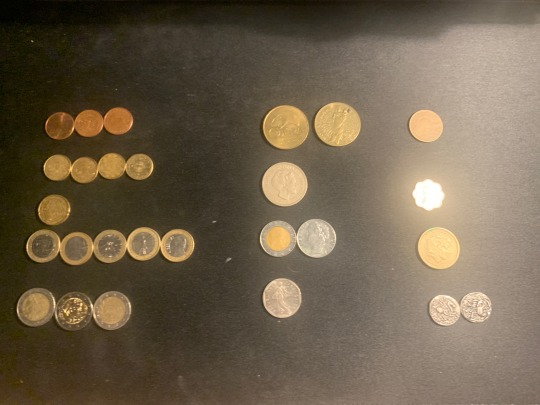
(LONG POST)
Here's the Euros Ive got:

And then the other currencies! (Decorative souvenir coins from France, Kroner, Liras, Francs, Dirham, East Caribbean cents, Modern Drachmae and Ancient Drachmae):
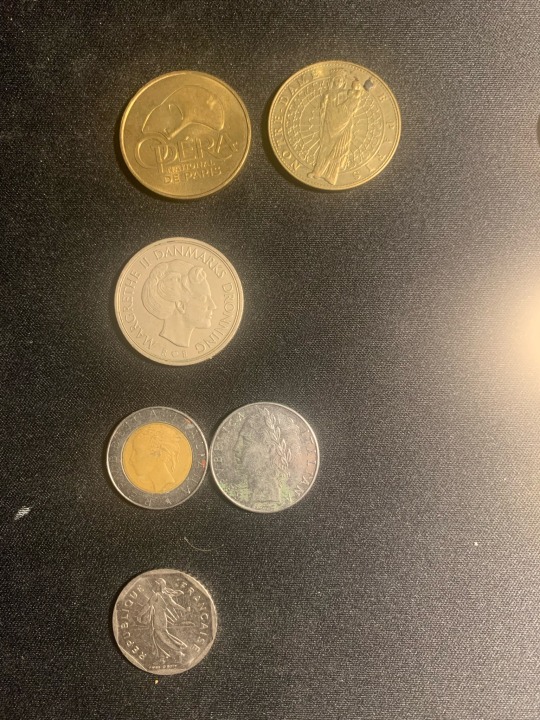
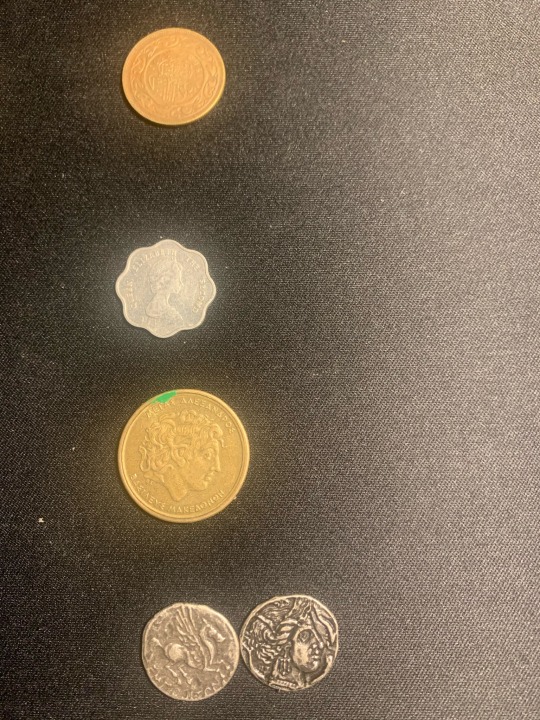
My favorites include:
10 cents (2006) with the face of Venus (Italy)
1 Euro (2010) with the owl of Athena (Greece)
1 Euro (2009) with the vitruvian man (Italy)
2 Euro (2002) with the rape of Europa (Greece)
500 Liras (1987) with the face of Hermes (Italy)
100 drachmae (1990) with the face of a horned Alexander the great (Greece)
Decorative Notre Dame coin (2006)
5 cents (1984) with a curious flower-like shape (East caribbean states)
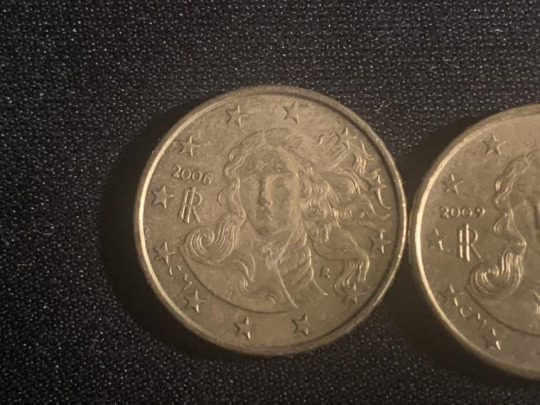
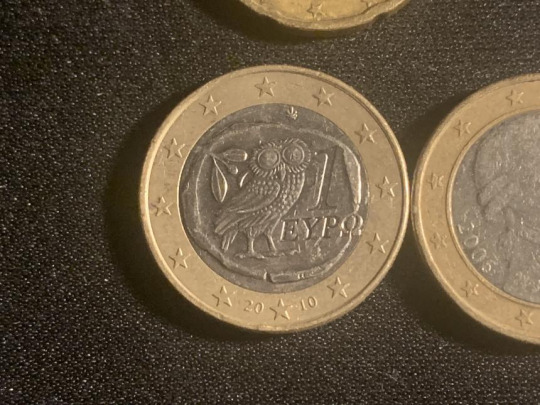

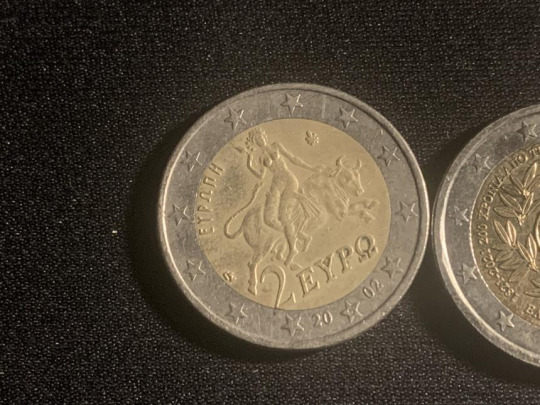
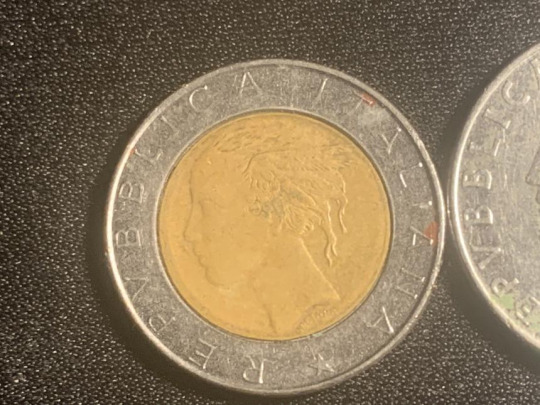
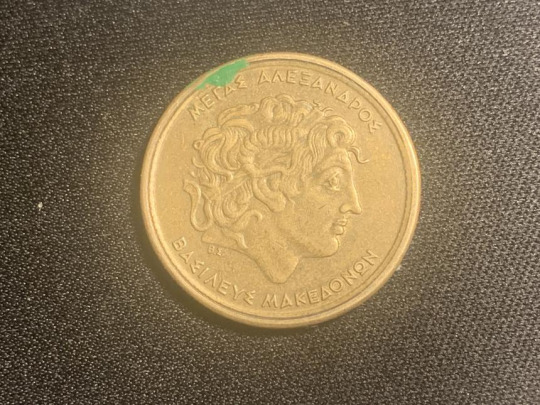

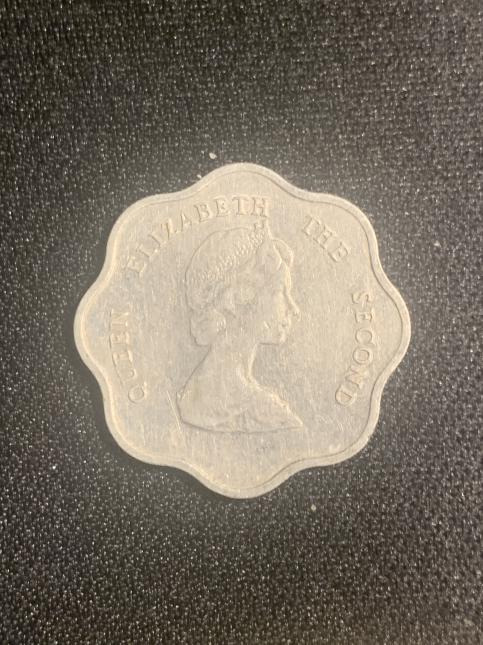
Regards the ancient drachmae, they are Emporion drachmae (3rd century replica) I bought at the Archeological musem, here's the actual coin:
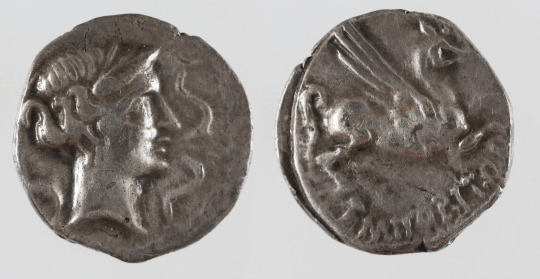
These were brought to Spain by greek traders to the city of Genova, Mallorca. The 1990 drachmae is honestly the best of the bunch, the engraving of the face is very visible and well kept except for a green paint stain and some scratches:
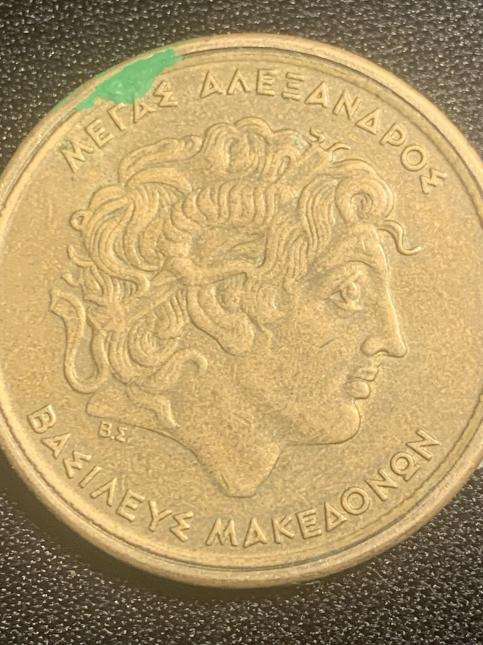
"Μεγασ Αλεξανδροσ, Βασιλευσ Μακεδονων" (Megas Alexandros, Vasilefs Makedonon) Transl. Alexander The Great, Macedonian king (If anyone who speaks greek is seeing this and I got the translation wrong IM SO SORRY grr i can understand it to a CERTAIN but LOW level)
In total I have:
11,75 euros
5 kroner
600 Liras
2 Francs
50 dirham
5 East caribbean cents
102 drachmae (Counting the older coins just by the amount i got, although im sure the value of the older drachmae would make this number less exact)
If anyone's curious the decorative coins are from the Paris Opera and Notre Dame! :) I got the opera coin because I am a huge nerd of both classic opera and The Phantom of The Opera sooo :P! I keep them in a bag so far because I need to get a proper place to put them in, lets hope I find more silly coins to add! I almost got some roman Denarians with Caesar engravings (There was one with Hadrian) but they were abysmally expensive (The Drachmae cost 6 euros something something each, which I dont blame them, its literal SILVER. And the denarians were gold, but of course they aren't legitimately 100% gold, of course, it's a mismash of metal.) There were other coins such as golden spanish escudos from the middle ages who were 7 each, they were HUGE.
#I just really like coins guys im normal about them#I got the ancient drachmae from a museum it was awesome#they are made of silver#the crypt opens once again
6 notes
·
View notes
Text

Plate with Sphinx from the Greek colony and emporion of Naucratis in Egypt. 6th century BCE. Herodotus was the first author who described in his Histories the creation and development of Naucratis under the Pharaohs of the Saite dynasty.
Source: https://www.francetvinfo.fr/monde/naucratis-cite-antique-redecouverte-dans-le-delta-du-nil_1717439.html
5 notes
·
View notes
Text
Culcas
Culcas fue un Rey de los Turdetano-tarteso de finales del siglo III a.C. y principios del II a.C., quien gobernó hasta 28 ciudades desde Jaén hasta Carmona, y formó parte de la Rebelión Iberá (197-195 a.C.) contra la invasión de Roma.
La rebelión encabezada por Culcas se extendió como la pólvora hacia las tierras del norte; entre los muchos otros reyezuelos y jefes que se unieron a su causa destacó por su importancia Luxinio, Rey de los Bastetanos. Culcas y Luxinio contrataron inicialmente a 10 mil guerreros celtíberos, conocidos por su especial valor y dureza en la batalla, quienes fueron mandados por sus propios cabecillas, Budar y Besadino, para que se sumaran a sus tropas turdetanas. La revuelta hizo que los romanos perdiesen el control efectivo sobre numerosas regiones.
Iniciada la revuelta en la provincia Ulterior, la del sur, liderada por Culcas, Roma envió a los pretores Cayo Sempronio Tuditano a la provincia Citerior y Marco Helvio Blasión a la Ulterior. Poco después de que la rebelión se propagase hasta la provincia Citerior, Cayo Sempronio Tuditano murió en combate. Sin embargo, Marco Helvio Blasión, que al llegar a su provincia consiguió una importante victoria sobre los celtíberos en la Batalla de Iliturgi (Mengíbar, Jaén). La situación seguía lejos de estar controlada, y Roma envió a los pretores Quinto Minucio Termo y a Quinto Fabio Buteón en un nuevo intento de solucionar el conflicto. No obstante, aunque éstos lograron algunas victorias, como en la Batalla de Turda (quizá Requena, Valencia), donde Quinto Minucio logró incluso capturar a Besadino, tampoco consiguieron resolver del todo la situación.
Fue entonces cuando Roma hubo de enviar en 195 a. C. al cónsul Marco Porcio Catón al mando de un ejército consular a suprimir la revuelta, quien, cuando llegó a Hispania encontró toda la provincia Citerior en rebeldía, con las fuerzas romanas controlando sólo algunas ciudades fortificadas. Catón estableció una alianza con Bilistages, Rey de los Ilergetes, y contaba también con el apoyo de Publio Manlio, recién nombrado pretor de Hispania Citerior y enviado como ayudante del cónsul.
Catón se dirigió hacia la Península Ibérica, desembarcó en Rhode y sofocó la rebelión de los hispanos que ocupaban la plaza. Posteriormente se trasladó con su ejército a Emporion (Ampurias, Gerona), donde se libraría la mayor batalla de la contienda, contra un ejército indígena ampliamente superior en número. Después de una larga y difícil batalla, el cónsul consiguió una victoria total, consiguiendo infligir 40 000 bajas en las filas iberas. Después de la gran victoria de Catón en la batalla decisiva, que había diezmado las fuerzas hispanas, la provincia Citerior cayó de nuevo bajo control de Roma.
Por otro lado, la provincia Ulterior seguía sin estar controlada, y el cónsul hubo de dirigirse hacia la Turdetania para apoyar a los pretores Publio Manlio y Apio Claudio Nerón. Catón intentó establecer una alianza con los celtíberos, que actuaban como mercenarios pagados por los turdetanos y cuyos servicios necesitaba, pero no logró convencerles. Tras una demostración de fuerza, pasando con las legiones romanas por el territorio celtíbero, les convenció para que volvieran a sus tierras. La sumisión de los indígenas iberos era sólo en apariencia, y cuando corrió el rumor de la salida de Catón hacia Roma, la rebelión se reanudó. Catón hubo de actuar de nuevo, lo cual hizo con decisión y efectividad, venciendo a los sublevados definitivamente en la Batalla de Bergium (posiblemente Berga, Barcelona). Finalmente, Catón vendió a los cautivos como esclavos y los indígenas de la provincia fueron desarmados. Un total estimado de unos 80 000 combatientes iberos más un número indeterminado de civiles muertos fue el costo de la victoria de Roma.

1 note
·
View note
Photo


July 12, 2021 | Indiana Jones and the Last Crusade
Lately I have been (re)watching Indian Jones movies starring Harrison Ford, and today I watched Indiana Jones and the Last Crusade (1989). In this movie we get a look into Indiana’s youth—and his relationship with his father, Henry Jones, Sr. For example, initially he was not scared of snakes, flicking one away; however, he ends up SUBMERGED in them. (They look to be ribbon snakes, which are not venomous? Still, scary stuff, though.)

One scene that is pretty standard in most (if not all) of the movies is Indiana in the university classroom, teaching some archaeology course. “Next week,” the class will be learning “Egyptology, starting with the excavation of Naukratis by Flinders Petrie in 1885.”
As I did not take Dr. Jones’s course (or any other course) on Egyptology, we are going to Britannica for more information. According to Britannica, “Naukratis, also spelled Naucratis, [is an] ancient Greek settlement in the Nile River delta, on the Canopic (western) branch of the river. An emporion (‘trading station’) with exclusive trading rights in Egypt, Naukratis was the centre of cultural relations between Greece and Egypt in the pre-Hellenistic period. The station was established by Milesians in the 7th century BC, but Greeks from other cities also settled there. It flourished throughout the classical period but declined after Alexander’s conquest of Egypt and the foundation of Alexandria (332). The site of Naukratis was discovered in 1884 by W. M. Flinders Petrie and excavated by Petrie and Ernest Gardner (1884–86) and by D. G. Hogarth (1899, 1903). They uncovered dedications to deities and Greek pottery that threw light on the early history of the Greek alphabet and the commercial activity of various Greek states, especially in the 6th century BC.”
The map below shows where Naukratis is relative to other ancient Egyptian cities (source).

The story in the movie took place elsewhere, that is, not in Egypt. Egypt already got its own Indian Jones movie in Raiders of the Lost Ark (1981).
On a very unrelated note, near the end of the movie there is a scene (which I will provide no context to) that caught my eye because of four words: “Elsa” and “Let it go.” Elsa does not say “let it go.” Still ... “Let it go, let it go / Can’t hold it back anymore / Let it go, let it go / Turn away ...” More like, let him go.



And later:

[Screenshots of Indiana Jones and the Last Crusade]
#l'egypte est partout#egypt#egyptology#ancient egypt#Indiana Jones and the Last Crusade#indiana jones#last crusade#chalice#let it go#elsa#henry jones#harrison ford#egypt in film#Naukratis#Naucratis#Egypt in history#nile delta#emporion#greece#Milesians#Flinders Petrie#Ernest Gardner#Hogarth
4 notes
·
View notes
Text

Empúries (Emporion/Ἐμπόριον), Catalonia
#empúries#emporion#greek architecture#greek art#roman art#roman architecture#greek#roman#ancient ruins#aesthetic#mine#personal#architecture#aesthetics
56 notes
·
View notes
Text
New Board Game Pits Archaeologists against Treasure Hunters in Archaeological Sites All across Bulgaria
New Board Game Pits Archaeologists against Treasure Hunters in Archaeological Sites All across Bulgaria
The “Archaeologists vs. Treasure Hunters” board game developed by the Archaeologia Bulgarica NGO raises awareness about the daily battle against destructive treasure hunting in tens of thousands of archaeological, historical, and cultural sites all across Bulgaria. Photo: Archaeologia Bulgarica
A new board entitled “Archaeologists vs. Treasure Hunters”, which pits the two groups against one…
View On WordPress
#Ancient Rome#Ancient Thrace#Antiquity#Apollonia Pontica#Archaeologia Bulgarica#archaeologist#Archaeologists vs. Treasure Hunters board game#Black Sea#Black Sea coast#board games#burial mound#burial mounds#Danube#Danube River#Debelt - Deultum Archaeological Preserve#Deultum#emporion#forged artifacts#georadar (GPR)#Gotse Delchev#ground penetrating radar#Kozarnika Cave#Kyustendil#Late Antiquity#Lyudmil Vagalinski#Lyutitsa Fortress#Mesembria#metal detector#metal detectors#Middle Ages
1 note
·
View note
Text
https://vrallart.com/vr-exhibitions/em/intermedit_project/
Do you have virtual reality glasses? You'll be able to visit the 3D exhibition "The Mediterranean Exchange in Antiquity", where you'll be able to step inside the reconstruction of the Ancient Greek city of Emporion (modern-day Empúries, Catalonia), Punic archaeological sites in Eivissa (Balearic Islands), and the Roman oppidum of Ensérune (Occitania). You can also see 3D scans of archaeological objects found in all these places.
#archaeology#empúries#eivissa#arqueologia#ancient mediterranean#ancient history#virtual reality#museums#archeology
48 notes
·
View notes
Text
the real reason nintendo wont make a sinnoh remake is cause theyre scared of having to redo all the ball capsules
#finaly got to sunnyshore#guess what the fuck im spending all my money onnn#just spent the last half hour gettin those capsules so right#my team looks sick as hell#im using giratina in my final team cause i love them and have missed them#my kadabra also has been strugglin so#sorry buddy#love u but ur gonna have to sit this one out#tasha tells tales#so ive got starraptor#ponita#luxray#emporion#roserade#and giratina#all of which have maximum friendship cept giratina but thats ok cause theyve got the sooth bell or whatever and were gonna make it happen#gonna beat the last gym n then do the elite four#make it HAPPEN#tho i need to grind a bit cause i was sssssooo underleveled in the last cyrus fight#im talkin 5 levels under his pokes#not a good situation#still won tho ha
1 note
·
View note
Note
4, 7, 31 (me han encantado los otros random facts de los q has hablado!!)
ay gracias jo 🥺
4. what are you looking forward to?
tbh? nothing 😬 i honestly have no motivation for anything and there's nothing that excites me right now or that i look forward to. now that i think about it my mum told us this year we're gonna go on a cruise for the first time ever to 'celebrate' her being fired last year, but honestly those types of plans never come to fruition in my family so i don't even know if we're gonna do it in the end (for example during the christmas season i asked them to go one (1) day to the sierra to see the mountains and they told me we'd do that and it's february and i haven't seen one mountain; but my sister went with her friends to the sierra like a couple weeks ago 🥴)
7. what was your life like last year?
the first half was okay-ish, i was doing my masters in a new uni and having an internship for the first time in my life in a really cool place... but then summer came, and it all went to shit. i spent the other half of the year mostly at home, fighting administrative shit and being unable to find a job, and just letting anxiety and seasonal depression consume me. so yeah, not a very good year :))
31. 3 random facts
despite what we were told in school, the celtiberii weren't the mix between celts and iberians, but a specific subgroup amongst the celtic tribes along parts of the ebro valley and the iberic system (more or less the southern half of aragón, soria, guadalajara... that area), they were called like that cause they were 'the celts beyond the iber river'. those were the tribes that resisted more the conquest of rome, and that's why they're so well known (you might know about the siege of numantia, one of the darkest events in roman history and a symbol of resistance against imperialist powers)
emporion, now modern ampuriès, was the western-most city state in the ancient greek realm
there were three hispanic roman emperors: trajan, hadrian (both from italica, modern santiponce, in sevilla) and theodosius I (from cauca, modern coca, in segovia). martial, one of the greatest roman poets, who lived between the 1st and 2nd century AD, was also hispanic, he hailed from bilbilis (modern calatayud, in zaragoza).
#ask#i tried to cater the random facts to you i hope you like them :)#also of course the hypothetical cruise would be on the mediterranean there's no other option lol
7 notes
·
View notes
Text
Get out of the Attic

Something I’m finding as I do more research for my novel, is that the more I study the Classical Greeks, the less interested I get in the Attic and Peloponnesian cities and the more I want to learn about the farther-flung Greek city-states. I feel like traditional scholarship of the Classical era draws at least 90% of it’s knowledge from cities like Sparta, Athens, and Corinth, treating what we know of their culture as somehow universal of Greek culture.
Meanwhile, so little scholarship I’ve found places much focus on Ionian cities like Sardis or Halicarnassus or on Greco/Italian cities like Taras or Heraclea---even the Macedonian Greek cities don’t seem to receive much scholarship until the rise of Philip II. How many of these assumed truths about Greek culture, religion, warfare, etc applied to Syracuse and the other Sicilian Greek cities, or to Cyrene in Libya, Massilia in Gaul, Bosporus on the Black Sea, or Emporion way out in Spain? (Not to mention Hellenic influences spread by Alexander’s conquests.) And when I do find info on them, it’s almost always filtered through the lens of their relations with the Attic and Peloponnesian cities or with Alexander IV or even later relations with Rome.
Like the Classical Spartans, Athenians, and Corinthians themselves, a lot of western historians seem to have glommed onto the idea that ‘real’ Greek culture came from these core cities. Meanwhile, the hundreds of cities and colonies outside the Greek mainland are often treated as somehow less valid due to their proximity to barbarian cultures. (The Ionian city-states especially. Apparently having been part of the Persian Empire makes them even less valid somehow. Nevermind that three of the Seven Wonders of the Ancient World were located in Ionia, while the Greek homeland only had one...)
And maybe this is less a problem in academic circles, but I badly would like to see more scholarship on the things that set the more distant city-states apart from the Greek homelands. I think that kind of oversight is a lot of the reason why in my novel, Queen Viarra’s hegemony ended up being more Macedonian/Ionian-inspired, while her rival empire and their allies were inspired more by Corinth and Athens.
10 notes
·
View notes